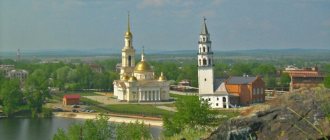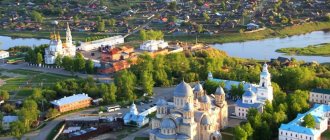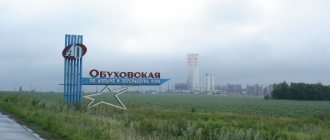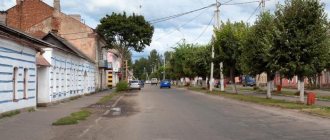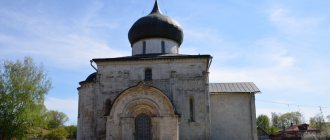City in Sverdlovsk Oblast, Russia
For other places with the same name, see Sukhoi Log.
City in Sverdlovsk Oblast, Russia
| Sukhoi Log Sukhoi Log | |
| City [1] | |
| Flag Coat of arms | |
| Location of Sukhoi Log | |
| Sukhoi Log Location of Sukhoi Log Show map of Russia Sukhoi Log Sukhoi Log (Sverdlovsk region) Show map of Sverdlovsk region | |
| Coordinates: 56°55'N 62°01'E / 56.917°N W. 62.017°E / 56.917; 62.017 Coordinates: 56°55'N 62°01'E. / 56.917°N 62.017°E / 56.917; 62.017 | |
| A country | Russia |
| Federal subject | Sverdlovsk region [1] |
| Administrative region | Sukholozhsky district [1] |
| Town | Sukhoi Log [1] |
| Based | 1710 |
| City status from | 1943 |
| Height | 170 m (560 ft) |
| population size (2010 Census) [2] | |
| • General | 34 554 |
| • Evaluate (2018) [3] | 33 689 ( -2,5% ) |
| Administrative status | |
| • Capital from | Sukholozhsky district [4], Sukhoi Log |
| Municipal status | |
| • Urban district | Sukhoi Log urban district [5] [1] |
| • Capital from | Sukhoi Log urban district [6] |
| Timezone | UTC+5 (MSK+2[7]) |
| Postal code [8] | 624800, 624802–624804 |
| OKTMO ID | 65758000001 |
| Web site | goslog.ru |
Sukhoi Log population
| 2010 Census | 34 554 [2] |
| 2002 Census | 36 407 [9] |
| 1989 Census | 36 577 [10] |
| 1979 Census | 31 954 [11] |
Sukholozhsky
(Russian: Sukhoi Log, burning
dry ravine
) is a city and the administrative center of Sukholozhsky District in Sverdlovsk Oblast, Russia, located on the eastern slopes of the Ural Mountains on the Pyshma River ('s basin), 114 kilometers (71 mi) east of Yekaterinburg. administrative center of the region. At the 2010 census its population was 34,554. [2]
Links[edit]
Notes[edit]
- ^ abcdefg Order No. 120-P
- ^ abc Federal State Statistics Service (2011). “All-Russian Population Census 2010. Volume 1" [All-Russian Population Census 2010, vol. 1]. All-Russian Population Census 2010 [All-Russian Population Census 2010]
. Federal State Statistics Service. - "26. The size of the permanent population of the Russian Federation by municipalities as of January 1, 2022". Federal State Statistics Service. Retrieved January 23, 2022.
- ^ ab State Committee of the Russian Federation on Statistics. Committee of the Russian Federation for Standardization, Metrology and Certification. No. OK 019-95 January 1, 1997 “All-Russian classifier of objects of administrative-territorial division. Code 65 240”, ed. changes No. 278 / 2015 dated January 1, 2016. (Goskomstat of the Russian Federation. Committee of the Russian Federation for Standardization, Metrology and Certification. No. OK 019-95 January 1, 1997. Russian classification of administrative divisions) (OKATO).
Code 65 240 as amended by Amendment No. 278/2015 dated 01/01/2016). - ^ ab Law No. 85-OZ
- Federal State Statistics Service. Federal Agency for Technological Regulation and Metrology. No. OK 033-2013 January 1, 2014 “All-Russian classifier of municipal territories. Code 65 758 ". (Federal State Statistics Service. Federal Agency for Technological Regulation and Metrology. No. OK 033-2013 dated January 1, 2014. Russian classification of municipal territories. Code 65 758.
). - "On the Calculation of Time". Official Internet portal of legal information
. June 3, 2011. Retrieved January 19, 2022. - Post office. Information and computing center of OASU RPO. ( Post office
).
Search for postal service objects ( postal Search for objects
) (in Russian) - ↑
Federal State Statistics Service of Russia (May 21, 2004).
“The population of Russia, the constituent entities of the Russian Federation as part of federal districts, urban settlements, settlements, settlements is 3 thousand or more people” [Population of Russia, its federal districts, federal districts, districts Urban settlements, rural settlements - administrative centers and rural settlements with a population of over 3,000] (XLS). All-Russian Population Census 2002
. - “All-Union Population Census of 1989. The current population of union and autonomous republics, autonomous regions and districts, territories, negative phenomena, urban settlements and rural district centers” [All-Union Population Census of 1989: current population of union and autonomous republics, Autonomous regions and districts , territories, regions, districts, urban settlements and villages performing the functions of district administrative centers. All-Union Population Census of 1989 [All-Union Population Census of 1989]
.
Institute of Demography of the National Research University: Higher School of Economics [Institute of Demography of the National Research University: Higher School of Economics]. 1989 - via Demoscope Weekly
. - “All-Union Population Census of 1979. National composition of the population by regions of Russia” [All-Union Population Census of 1979. Ethnic composition of the population by regions of Russia] (XLS). All-Union Population Census of 1979 [All-Union Population Census of 1979]
.
1979 - via Demoscope Weekly
(website of the Institute of Demography of the State University - Higher School of Economics.
Sukhoi Log was founded in 1680-1682 by people from the village of Shartash
(near Yekaterinburg), whose residents were considered working people of the Stroganovs. Several families left Shartash and settled near the Pyshma River, in an area called Sukhoi Log.
According to surveys of old-timers, it turned out that the founders of the village of Sukhoi Log were: 1. Bykov Yakov Vasilyevich (founder of the Yakunyat family) 2. Efremov Ignatiy Vladimirovich 3. Sukhonosov Daniil Dmitrievich.
These three families, having settled in dry logs, began to acquire a household. At first they lived in dugouts, which were located near the mountain where 6 Sovetskaya Street is now.
Their initial occupation was hunting and fishing. Gradually they began clearing land for arable land. When we finally took a closer look at the new places, we began to build houses.
Their construction was carried out jointly. The first house was built by the family of Y.V. Bykov, who was considered the eldest among the settlers. The estate where this house stood is now located on Shulin Street, 24.
In the early nineties of the 19th century it was rebuilt (rebuilt). During the reconstruction of the house by Vasily Andreevich Bykov, under the matka (main beam) a letter was found, issued by the Stroganov brothers in 1675 in the name of Vasily Bykov and his son Yakov, according to which they were freed from serfdom and were allowed to live in any area they wished. This certificate was handed over to the Shadrinsk Museum of Local Lore in 1924.
The Efremov house was built on the site where the estate of Fyodor Vasilyevich Brylin is currently located, along Lenin Street. The Sukhonosovs' house stood near the present estate of I.I. Perevalov, along Klyuchevskaya Street (towards Lenin Street). These three houses were built approximately in the 1700-1720s.
An indirect confirmation of the existence of Sukhoi Log from this period is the following fact described in the local newspaper. In 1954, Alexander Pavlovich Egorov, while cultivating his garden, which is located on the former estate of Mikhail Grigorievich Efremov, came across an old treasure that contained 61 kg of copper coins minted from 1540-1670 and 18 silver coins weighing 400 grams.
The Bykov family has preserved a legend about the death of the first resident of Sukhoi Log, Yakov Vasilievich Bykov. When he became very old, he ordered his relatives to take him to Shartash before his death and bury him there, and if this failed, then to bury him under a pine tree that grew on the right bank of the Pyshma and was visible from the window of his house. Soon he fell ill, they put him on a cart and took him to Shartash, but they took him only to a place called Petukhov Vzvoz (a mountain on Lenin Street, where store No. 15 is now located) and then on the cart, Y.V. Bykov. died. His corpse was brought back home and buried under the indicated pine tree. The first Sukholozhsky cemetery was founded around this pine tree. It was located on the right side of the now existing Voroshilov Street.
In 1847, coal mining began in the territory adjacent to Sukhoi Log. The development was carried out by some merchant. He supported many peasants brought from different parts of the country to work in the coal mines. This is where the population of Sukhoi Log increased, many so-called working people appeared.
The first mine was founded where Market Street is now. A little later, an adit was laid where Krasnoarmeyskaya Street is now, to the left of Lenin Street; in this place you can still see a semblance of a log. This is a collapsed adit. A collapse occurred in 1860, during which people, horses and equipment were buried. Along the line of this adit, two shafts (pipes) were made, which served as vents and at the same time for supplying rock. One was located opposite the kindergarten on Lenin Street, and the other in the place where store No. 34 is now. The adit went to the place where the estate of Stepan Alekseevich Pyankov is now located.
In addition, there were two mines on the Novaya Polyana site and on the left side of the Pyshma River; two mines on the road to Irbit Peaks (Altynai) and two mines behind the railway. The mined coal was transported on horseback to the city of Yekaterinburg and further to the Kama-Votkinsk plants. In 1868 (according to local historian E.E. Leontyev in 1861), the development of coal mines in Sukhoi Log was stopped. According to some data, for the Siberian Paper Mill, coal was mined at the Novaya Polyana site until 1878.
In the sixties of the last century, the production of lime was started by the wife of a coal mine tenant. The foreman at this production was Alexey Yakovlevich Olesov, who later became an independent tenant of lime kilns. In addition to him, at various periods the tenants were: Vasily Bykov (Pronichev), Petr Mikhailovich Bykov, Nikolay Efimovich Bersenev (Kozhanok) and Alexander Timofeevich Morev.
The first water mill in Sukhoi Log was built in 1725-1730 by the Bykov family (Yakunyat). The location was chosen poorly (opposite the current Zagotskot office). Every year, the hollow water broke the earthen rampart and sometimes demolished buildings. Therefore, in the eighties of the eighteenth century, the same Bykovs built another water mill on the Pyshma River where the Bykovsky village is now located. Hence its name, since the land plot belonged to the Bykov family.
This mill was demolished in 1860, and the land plot was sold to a coal mine tenant, who sold it to Ivan Yakovlevich Yates in the late seventies. The latter built a house and a summer cottage on this site, and in 1912 began building a factory for the production of wood cardboard. Construction was stopped in 1917.
Above Sukhoi Log on the Pyshma River in 1890, Nikolai Antonovich Berinov built a water mill, the building of which has survived to this day with a dilapidated dam. In 1913 it was sold to Suturikin. According to the stories of some people, the mill was lost at cards by Berinov's son. The area located between the village of Sukhoi Log and Deciduous Log, on the one hand, the Pyshma River and the Trans-Urals, on the other hand, in those days was covered with a dense pine forest, in which there were many squirrels and other animals. This forest was a quitrent item of state importance. In the early nineties (1907-1908), the forest was predatorily cut down.
In this forest, in the place where the pipe and slate shops are now located, there was a swamp in which there was an area of approximately 40-50 square meters. meters, where the water did not dry up in any dry summer. In this swamp there were a lot of small insects that in appearance resembled lice, and therefore this swamp was called “Lousy”.
According to the stories of the Efremovs Efim and Nikolai Spiridonovich, until the forties of the last century (the beginning of the development of coal), there were only three surnames in Sukhoi Log: the Bykovs, the Efremovs and the Sukhonosovs. Only the Bykovs lived on the left side of Pyshma, and the Efremovs and Sukhonosovs lived on the right.
The streets were called
by last names or nicknames of residents, where they lived. For example, Spirin Street - named Efremova, across the river, Filicheva Gora or Yakunyatskaya - nicknamed Bykov, and where the Sukhonosovs lived - the place was called “At the Key”.
Since the beginning of the development of coal mines, many new residents have come to Sukhoi Log, as a result of which there has been an increase in the number of estates (yards) and, accordingly, streets. For example, Tatarovka Street appeared near the existing cemetery, people who spoke broken Russian settled on it; the street near Klyuch received the name – The End.
By 1916, the following street names had developed: Chernolyagina - Lenina Spiryatskaya - Pionerskaya End - Svobody Kazanyatsky region - Voikova Road to the shops - Dzerzhinsky At the key - Klyuchevskaya At the key - Krasnoarmeyskaya Morevsky end - Paris commune Tatarovka - Voroshilova Filicheva Gora - Krasnaya Gorka Filicheva Gora - Soviet Road beyond Usolka – Proletarskaya Road to the Ananyevs – Shulina Beregovaya – Embankment
The names from those times remained: “Melnicheva Steppe” after one of the representatives of the Efremov family and “Yakunyatskaya Rareka”.
The first wooden chapel (Old Believer church) in Sukhoi Log was built in 1725 on the very spot where the House of Culture is now located. Later, a small brick church was built on the same place, and the chapel was transported and placed on the so-called Rostan roads of Shata - Kurya and Sukhoi Log - Kashino (the place where the city hospital is now located). In 1929, the chapel was dismantled, and the logs from it were used as firewood for lime burning.
Construction of the new church began in 1847 and was completed in 1854. It was carried out by the strength of local residents, only artisans were hired at the expense of funds collected by the trusteeship (these were people who walked around with a mug on their chest and collected money for the construction of the temple). Before the completion of the construction of the church, an accident occurred: Vasily Efimovich Beresnev, who worked there, fell from the scaffolding around the so-called large dome, and as a result of the fall and bruise, his arms and legs were paralyzed. The rural community paid this Bersenev an allowance of five rubles a year until his death.
In 1929, by decision of a meeting of citizens of Sukhoi Log, the church was closed and ceased to exist as such. Its building was used for various purposes, and currently it houses the House of Culture.
Construction of the first school in Sukhoi Log began in 1853 and was completed in 1858. It was a parochial three-class one-room school with 30 places. In the first years, the number of students did not exceed thirty people. The first teacher was Lyapustina Elizaveta Andreevna, who taught there for about 30 years.
In 1879, the Kamyshlovsky district zemstvo in Sukhoi Log built a new school building and opened a zemstvo three-class elementary school. On January 1, 1889, Alexandra Evgenievna Lyapustina, who graduated from the Kamyshlovsky gymnasium in 1883 and had previously worked as a teacher’s assistant at the Kashin elementary school, was appointed teacher at this school. According to Lyapustina, in 1889 there were only 34 students at the school, and in 1890 the number increased to 50. For 15 years Lyapustina worked alone, and only in 1904 there were two teachers at the school. The second teacher was Yulia Mikhailovna Troitskikh. In 1903, a school library was opened. In 1897 Lyapustina A.E. carried out the main work in Sukhoi Log on the first All-Russian population census carried out at that time. In 1903, for good work, the Kamyshlovsky district zemstvo government, by its decision, awarded Lyapustina A.E. building her a house, in which she lived until her death in 1950. Lyapustina taught children at the Sukholozhskaya school until 1924, i.e. before retirement.
Before the revolution, there was a state wine shop (tavern) and two groceries (shops) in Sukhoi Log. The first belonged to the richest resident of the village, Dmitry Nikolaevich Afonasyev, who, in addition to it, also had a tannery for tanning raw leather. The second shop belonged to the Kamyshlovsky merchant Meshcheryakov, in which his clerk, Vasily Efimovich Boyarinov, traded.
Consumer society
was organized in 1914, it initially consisted of 116 members - shareholders, in 1915 their number grew to 350 people. The composition of the first board of the company was as follows: Bykov Fedor Petrovich (chairman), Bykov Osip Petrovich, Bykov Semyon Ivanovich, Rubtsov Petr Fedorovich and Bykov Ivan Petrovich. At the beginning, the consumer society rented premises for a store from one of the villagers, and by 1915 they built their own store (currently store No. 15 is located in this building).
In June 1921, the Sukholozhsk Credit Partnership was organized with the number of shareholders - 18 people; Bykov Ivan Yakovlevich was elected chairman. In 1923, on the basis of the Sukholozhsky, Rudyansky and Novopyshminsky credit partnerships, the Kuryinsky branch of the State Bank was organized.
Before the revolution, the village of Sukhoi Log was part of
part of the Znamenskaya volost of the Kamyshlovsky district of the Perm province. After the liberation of the Urals from the White Guards, Sukhoi Log was separated from the Znamenskaya volost and in August 1919 the first constituent volost congress of Soviets was held, but in which the first Executive Committee of the volost Council was elected. Bersenev Pavel Ivanovich was elected the first chairman of the volost executive committee. The first chairman of the Sukholozhsky Village Council after the expulsion of the Kolchakites was Pavel Artemyevich Bykov.
Source: Efremov Andrey Dmitrievich, Hoary legends, “Sukhoi Log and Sukholozhsky district”, part III, 1966.
